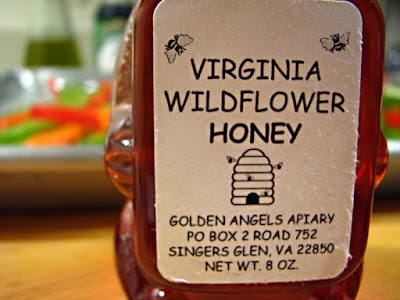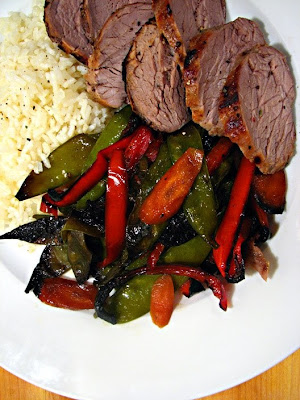Although now I, happily, spend much of my time cooking for a man, I did, in my more youthful and culinarily inexperienced years, enjoy having a man cook for me. My junior year in college, I lived in a single-person dorm that was the size of a walk-in closet, and, with no kitchen of my own, my meals usually consisted of ice-cream scoop-mounded piles of the cafeteria's mystery meat du jour. But sometimes I'd pack a bag and leave campus for a weekend and be served food—delicious food—that was made just for me by a man who enjoyed indulging my every request. There were dishes I asked for over and over again, pepperoni bread and crab-stuffed chicken breast being the most frequent two. But sometimes he'd plan the meals and I'd sit at the kitchen table, greedily sipping glass after glass of wine, waiting impatiently for whatever was being prepared for me.
He liked to use onions, an ingredient which, at the time, I insisted I didn't care for. He used so many that the smell would permeate the air of his small apartment and I'd rub my watering eyes and complain that I didn't know why he had to use so many onions. He'd refill my glass and chop another onion.

The particular meal I'm thinking of now was lasagna. The man may have turned out to be a dud, but the lasagna was not. It was delicious, and I still remember it as the best lasagna I've ever had. I don't know how he made it—at the time I was interested in eating, not cooking—but, besides the onions, I remember that the sauce was heavy on red wine. When the weekend was over, I returned to my dorm, lasagna-filled Tupperware in tow, and stored the leftovers in my mini-fridge. In the following days I ate the leftovers cold from the fridge for breakfast—then, breakfast was around 11:00 am—and it was as good cold as it had been warm.
These days, I'm with a man who is wonderful but whose overly picky tastes threaten to cramp my budding culinary repertoire. He's not impressed in the least with Italian food, he insists that all pasta is the same, and he hates tomatoes and ricotta cheese. What is a lasagna-loving girl to do?

Well, I make it anyway, that's what I do. But only rarely, and only when I find a recipe that seems especially tasty. I thought maybe Martha Stewart’s Lasagna Primavera would get by Adam. There are no tomatoes in it, after all, and it’s filled with veggies, so I thought I could pass it off as health food. But he didn't like the ricotta or the frozen spinach, which is the latest addition to his growing list of dislikes. He ate one piece of the lasagna, and only after he'd doused it in Red Hot.

I hope that, in telling you this, I'm not doing this lasagna a disservice. Adam is strange and peculiar and you can't go by his tastes. But you can certainly trust me, and I'm telling you that this lasagna is wonderful. It's so good that I had to spend the next week finishing the leftovers myself, and I didn't mind a bit.

If I had to make one complaint, though, I'd say that I wish the noodles themselves had stayed a bit firmer. The recipe calls for the lasagna to be cooked for 65 minutes--is it possible for noodles not to turn soft after that long? I don't know. I used oven-ready noodles, as the recipe advised, but, if I ever dare to make lasagna again, I might try using regular noodles, soaked very briefly in hot water, and see how that works out.

I had planned to serve the lasagna with garlic knots, but making the lasagna was not a speedy process, and I didn’t have it in me to bake anything else. I found, though, that the lasagna goes really well served with a very simple side of vine-ripened, lightly salted tomatoes. Enjoy!
Vegetable Lasagna
Adapted from Freeze-Ahead Lasagna Primavera
1/4 cup olive oil, plus more for foil
1 medium onion, diced
4 garlic cloves, minced
1/2 cup all-purpose flour
6 cups whole milk
2 packages (10 ounces each) frozen chopped spinach, thawed and squeezed dry*
1 package (10 ounces) frozen peas
1 cup finely shredded broccoli florets**
1/2 pound carrots (4 to 5), halved lengthwise and thinly sliced
Coarse salt and ground pepper
1/2 teaspoon freshly grated nutmeg***
1 container (15 ounces) part-skim ricotta (about 2 cups)
1 large egg
1/4 cup chopped fresh parsley
1 package (9 ounces) no-boil lasagna noodles (12 noodles)
1 pound part-skim mozzarella, shredded
1 cup grated Parmesan
Preheat oven to 400 degrees. In a large saucepan, heat oil over medium heat; add onion and garlic and cook until onion begins to soften, about 5 minutes. Add flour and cook, stirring constantly, 2 to 3 minutes (do not let flour mixture darken); whisk in milk. Bring to a boil, whisking frequently; reduce to a simmer, and cook, whisking occasionally, until thickened, 3 to 5 minutes. Add spinach, peas, broccoli, and carrots; season with salt, pepper, and nutmeg. Set sauce aside.
In a medium bowl, combine ricotta, egg, parsley, 1 teaspoon salt, and 1/2 teaspoon pepper.
In the bottom of a 9-by-13-inch baking dish, spread a thin layer of vegetable sauce. Layer 3 noodles, half the remaining vegetable sauce, another 3 noodles, half the ricotta mixture, half the mozzarella, and half the Parmesan; repeat.
Cover dish with lightly oiled aluminum foil, and place on a large rimmed baking sheet. Bake 45 minutes, uncover, and bake until bubbling and browned, about 20 minutes more. Let cool 10 to 15 minutes before serving.
* I used my salad spinner to get the water out of the frozen spinach. It takes a while, but remove as much liquid as you can, or else your sauce will be watery.
** I added the broccoli because I had some to use up, but it’s optional. If you choose to add it, just shred it as finely as you can with a sharp knife until it looks like it does in the picture above.
*** The nutmeg is optional, too, but I really like the flavor. Nutmeg is often paired with both cream sauces and dark greens.




























































